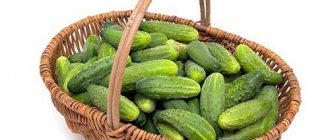Debates about the benefits and harms of white cabbage, especially for young children, have been going on for a long time. Indeed, it often causes bloating and worsens digestion, increases colic and increases gas formation in the baby. However, the negative effect will also be reduced by cooking or stewing.
Boiled or stewed white cabbage is digested easier and faster, while it fills the body with valuable vitamins, minerals and nutrients. Let's figure out when you can give your child white cabbage.
Composition, benefits and harm
White cabbage contains vitamins C and E, K and D, group B and rare vitamin U. Little is said about the latter, but with regular consumption it treats gastritis and ulcers, increases intestinal tone and normalizes liver function.
Vitamin D is especially useful for children, as it strengthens bones and prevents rickets. Since this substance is produced by the sun's rays, in regions with little sun, children do not receive enough of this important element.
Cabbage contains an increased concentration of ascorbic acid, which is responsible for immunity and good mood. This vegetable retains vitamin C for up to eight months, which only citrus fruits can boast of.
Cabbage performs the following beneficial functions and properties:
- Accelerates growth and restores cells, forms hematopoiesis;
- Has a beneficial effect on the functioning of the liver, kidneys and other internal organs;
- Normalizes metabolism, the functioning of digestion and intestines, eliminates constipation;
- Heals wounds and improves skin condition;
- Strengthens bones and teeth, heart and blood vessels;
- Cleanses the body of toxins and foreign proteins, waste and excess fluid, relieves swelling;
- Strengthens and supports the immune system, tones the body;
- Restores strength, gives vigor and energy, eliminates fatigue and improves mood;
- Calms and strengthens nerve cells, relieves stress and pain;
- Has a beneficial effect on the condition of the skin of the lips, eliminates cracks on the lips;
- Improves the absorption of iron, proteins and fats in the body;
- Normalizes cholesterol levels and protects against heart disease;
- Stimulates brain function;
- Useful for gastritis, gout and cholelithiasis;
- Increases appetite, but does not contribute to excess weight gain.
Cabbage is low in starch, sucrose and calories. Therefore, it is recommended for diabetes and increased weight. The vegetable is often included in the diet menu. However, it can also cause negative reactions, especially when eaten raw or fried.
This product is absorbed slowly and slowly, increases gas formation and worsens stool. May cause allergies and poisoning, pain and discomfort in the abdomen. To avoid a negative reaction, it is important to properly administer and prepare the product for your baby. Next, we will find out at what age a child can be given white cabbage.
Possible harm
Despite the large number of beneficial properties, this vegetable can also cause harm to the body, so you need to think in advance about whether it is possible to give your child white cabbage. This is due to the fact that the product takes a long time to digest and increases gas formation. All the problems are connected with this:
- deterioration of stool, despite the fact that cabbage helps to cope with constipation;
- the appearance of an allergic reaction (the product itself is hypoallergenic, a negative reaction may occur to other vegetables or fruits);
- the appearance of discomfort in the abdomen, which may be accompanied by pain.
Such negative consequences can be avoided by properly introducing cabbage into your baby’s diet and preparing the product according to age.
At what age can you
White cabbage should be introduced to your child after broccoli and cauliflower are included in the menu. By the way, these types of vegetables are considered the safest and healthiest. They do not cause allergies and are easily digestible, therefore they are optimal for baby food and first feeding.
White cabbage can be given to babies from about eight months. The first dish should be chopped boiled vegetables. A suitable solution would be puree soup. But pediatricians do not recommend giving cabbage in its pure form. Therefore, add carrots, broccoli, zucchini, potatoes or another vegetable that is already on your baby’s menu to the recipe.
The first time you need to give no more than half a teaspoon of puree. After the test, observe how the baby is feeling. If signs of food allergy or poisoning occur, delay administration and consult a physician. If the baby feels comfortable, cabbage can be cooked periodically for the baby.
If a baby has colic, frequent flatulence and diarrhea, or various digestive problems, it is not recommended to give cabbage until one year of age. Do not give your baby the stalk, as it absorbs and accumulates harmful substances that were used to fertilize the vegetable. And raw and fried cabbage is allowed only after three years!
Cabbage for children: cabbage recipes
Doctors do not recommend feeding white cabbage to infants. As mentioned above, this vegetable, in principle, is not advisable for consumption by children under 1 year of age, especially in its pure form. This is due to the fact that the product contains a large amount of coarse fiber, and this will lead to abdominal pain in the baby.
The best option would be to make puree for your child not from cabbage alone, but in symbiosis with other vegetables. We offer a similar recipe.
To prepare a puree that would include white cabbage, you can take any vegetables. It could be potatoes, zucchini, carrots, pumpkin. By the way, products need to be taken in small quantities.
Prepared products are peeled and cut into small pieces. The prepared vegetables are placed in a pan of water and boiled for 20-25 minutes, after which they should be mashed with a fork or chopped in a blender. Believe me, in this form the baby will definitely not refuse to try such a healthy dish!
It is recommended to introduce this dish into the baby’s menu closer to the age of one year due to the wide variety of components.
- Rinse potatoes, pumpkin, carrots and broccoli thoroughly.
- Peel, remove seeds, break into inflorescences.
- Cut the vegetables into cubes.
- Place the pan on the fire and bring to a boil.
- Throw all ingredients into bubbling water.
- Now you can add green peas.
- Cooking over low heat is recommended for about 30 minutes.
- You can add vegetable oil to the finished dish. Try not to add salt to your food.
So we got to know what cabbage is, we learned about the variety of types of this vegetable. Now you know which variety is best to start feeding with this vegetable. The main thing is not to forget to introduce each new species into complementary foods in small portions and only if it is well tolerated, increase the portion of the baby. And don’t think that if your baby isn’t allergic to broccoli, then he won’t be allergic to white cabbage either. This is not so, among other things, different types are characterized by the presence of unique substances in their composition, and also have different effects on the baby’s body. I wish you to go through this difficult path with ease and that your baby’s diet can easily increase by a whole range of vegetables, which will essentially be one type - cabbage.
Kids, as a rule, respond well to cabbage dishes. It does not burden the digestive system, cooks quickly, and has a pleasant taste.
Braised cabbage
For one serving you will need: 1 cabbage leaf, a couple of tsp. butter, 100 ml milk, 50 ml water, salt to taste. Chop the cabbage and simmer with water and milk. As soon as it softens, add salt and simmer for 2-3 minutes over low heat. Season with butter. Serve warm. Goes great with mashed potatoes and rice porridge.
Cabbage schnitzel
You will need a small head of cabbage, 4 tablespoons of breadcrumbs and the same amount of vegetable oil, 1 egg, 4 tablespoons. spoons of sour cream and salt to taste. The volume of products is designed for 4 servings.
Wash the cabbage, cut out the stalk, boil, and then place in a colander to drain the remaining boiling water. When it has cooled, squeeze it out with gauze, then divide it into pieces and make schnitzels 1-1.5 cm thick from them. Dip in beaten egg, then in breadcrumbs. Fry in a well-heated frying pan: first on one side, then on the other. Season with sour cream before serving.
Cabbage casserole
Cabbage leaf, a tablespoon of semolina, a teaspoon of butter, 100 ml of milk, a little sour cream and salt to taste. Stew the cabbage in milk, add salt to it, when the vegetable softens, add semolina (carefully, stirring constantly), cook for 5-7 minutes. Place the cabbage mixture in a mold, add a hard-boiled egg, chopped as for a salad. Bake for 5 minutes. Season with sour cream before serving.
In what form to give
Feeding cabbage starts with mashed potatoes and pureed soups. Then you can introduce stewed cabbage with other vegetables. After a year they include soups and casseroles, stews, dishes with meat and poultry. Do not give your children fried vegetables, as they are difficult to digest and cause heaviness in the stomach. In addition, when frying, the product loses most of its beneficial properties and elements.
Light vegetable soups are perfect. Start cooking with vegetable broth, and then move on to chicken and beef. Children's cabbage soup can be given as early as one year of age. Borscht is a heavier dish that is recommended for children only after two years. The beets and cabbage in this recipe are difficult and take a long time to digest and can cause a negative stomach reaction. And what soups are suitable for babies, see here.
If the baby tolerates cabbage well, salads with fresh vegetables can be introduced at two years of age. But many pediatricians do not advise introducing fresh, raw food before three years of age. Give preference to baked and boiled vegetables. Next, we offer cabbage dishes that you can prepare for your child.
Portal about vegetables: recipes, varieties, storage, cultivation
Cabbage is the most popular vegetable in the world, especially common in Europe, Mediterranean countries, Russia, China and Korea. It is difficult to find a vegetable richer in vitamins and minerals than cabbage. This extremely useful product is often unfairly ignored by young mothers for fear of harming the baby’s gastrointestinal tract. White cabbage is really difficult for children to digest, because it contains coarse fiber. At the same time, with proper preparation and small dosage, this vegetable will bring great benefits to the child.
Effect on the gastrointestinal tract
White cabbage has a positive effect on the child’s gastrointestinal tract. Vitamin U, or methylmethionine sulfonium, prevents any damage to the mucous membrane of the stomach and intestines. Thanks to this, the inclusion of cabbage in the diet allows not only to exclude the development of diseases such as gastritis and ulcers, but also helps to cure them. But this fact should not be decisive in the question of when you can give your child boiled white cabbage.
Also, white cabbage can help relieve any digestive disorders, for example, it stimulates a sluggish intestine. The fiber contained in the vegetable activates the intestines and cleanses the body of waste and toxins. Cabbage helps get rid of constipation and other disorders of the gastrointestinal tract.
At what age can a child be given white cabbage?
White cabbage must be present in children's diets. After all, it has a lot of useful properties:
- hypoallergenic;
- contains amino acids that promote the growth and development of the baby;
- low calorie content;
- produces enzymes that normalize the child’s digestion;
- contains a large amount of vitamins and minerals.
The first time a child can begin to be given cabbage during the period of introducing complementary foods in boiled form, on average at 6-8 months, and only on condition that the baby does not suffer from colitis. In this case, it is better to postpone the introduction to white cabbage until 1 year, and focus on more easily digestible varieties of cabbage - broccoli and cauliflower. By the age of 1 year, when the baby’s stomach is stronger, you can safely introduce dishes made from boiled white cabbage into the diet.
Cabbage can be eaten raw by children starting from 1 year old, if there are no diseases of the gastrointestinal tract. In its natural form, the white vegetable is extremely healthy. If there are no disturbances in the digestive system, then fresh cabbage can be given daily. If the digestive system has a negative reaction, the product can be introduced into the diet in fresh form only from 3 years of age.
Variety of this vegetable
Many mothers ask the same question: when can cabbage be introduced into their child’s diet? Some parents are sure that this product should be introduced into complementary foods almost first, however, in reality, everything is different.
So, basically, white cabbage is introduced from 7-9 months. They don't start complementary feeding with her. Before the product there are vegetables such as pumpkin, zucchini, carrots, potatoes, broccoli. However, white cabbage should be used as an additive to other purees.
It is worth noting that the stalk of the vegetable should not be eaten as it is toxic. The fact is that it is in this part of the product that harmful substances are concentrated, which people sometimes use during cultivation.
“There is medicine in a spoon, poison in a cup.” This famous saying applies not only to medications, but also, in some way, to products. What can be beneficial in small doses will be harmful if abused.
The child's body is especially sensitive to various irritants. In the first years of life, you should be careful about the presence of cabbage in your diet, because it:
- When consumed in large quantities, it leads to abdominal pain, flatulence and problems with stool (both constipation and diarrhea).
- The coarse fiber contained in cabbage can irritate the mucous membrane of the gastrointestinal tract (GIT), which leads to abnormalities in the digestive system.
- May cause allergies. The risk of this problem is minimal, but it also cannot be excluded. And increased histamine levels can provoke a pseudo-allergic reaction when allergy symptoms occur.
Broccoli
It is customary to start feeding a baby cabbage with broccoli for the first time. It is this representative that is the most harmless for the baby’s body. Such cabbage almost never causes colic or flatulence in a child. However, broccoli contains approximately 3 times more vitamin C and protein than white cabbage. Mothers should introduce their baby to this particular type of cabbage, and only then accustom him to others. But even in the case of this vegetable, you should not be zealous.
White cabbage
The most popular and widespread type of cabbage in our society. At what age are white cabbage given to children? As already mentioned, it cannot be introduced into the child’s diet until 7-8 months without first introducing other vegetables into the diet. White cabbage should first be used as an additive to vegetable puree made from other ingredients.
Recommendation. Take a close look at how your baby’s body reacts to cabbage. If something happens, complementary feeding with this vegetable should be discontinued for a while.
We have already said that white cabbage can cause flatulence and colic in babies, and sometimes allergies. Undoubtedly, there are also many benefits from consuming this variety. In particular, “classic” cabbage contains a huge amount of vitamins and minerals, with vitamin U occupying a special place. It also contains fiber and pectins, and cabbage juice produces enzymes and improves intestinal motility, which promotes better digestion.
Brussels
Brussels sprouts should appear in a baby’s diet no earlier than 7 months of age. It should be introduced into the diet before the white cabbage, of which it is a close “relative”. Brussels sprouts are rich in ascorbic acid and riboflavin (vitamin B2). However, it also contains a lot of fiber, which may not have the best effect on the baby’s health and cause bloating.
Marine
Can children under one year old eat seaweed? Strictly speaking, this product is not a vegetable and is not cabbage at all. Sea kale is a food product made from the brown algae Laminaria. And it should appear in a child’s diet only when he reaches 3 years of age, but even then it should be given in limited doses.
Reference. Sea kale has a large number of beneficial properties, but it is difficult to digest by the body, and the digestive system of an infant and a one-year-old baby simply cannot cope with such a responsible job.
Seaweed is most prized for its high iodine content. It also contains many vitamins, minerals, organic acids and amino acids.
Pickled
Like seaweed, sauerkraut should appear in a child’s diet after 3 years. Sauerkraut is, first of all, high in vitamins B, A, ascorbic acid, and minerals. It also contains a lot of fiber and vegetable protein. At the same time, a lot of salt is used in its preparation, which is extremely undesirable for children. Sometimes vinegar is also used, which is contraindicated for children.
READ MORE: How to help your baby with teething. How to help your child when teething
It is customary to start the first feeding with cabbage with broccoli. It is this representative that is the most harmless for the baby’s body. This cabbage is practically incapable of causing flatulence or colic in a child. This form contains three times more vitamin C and protein than regular white cabbage. After getting to know her, mom gradually accustoms her little one to other varieties of this group of vegetables.
Let's take a closer look at the pros and cons of using each type.
Young mothers often face the question of when to give their baby white cabbage. For some reason, some parents think that it should be one of the first to be included in the child’s diet. However, it is not. This type of cabbage can cause tummy problems in a baby. That is why it is introduced into the child’s diet a month after broccoli (at approximately 7 or 8 months) and they try to give it not as an individual dish, but as an additive to the main puree. As always, don’t forget to start with small portions, and if something happens, stop feeding this vegetable.
What are the main pros and cons of white cabbage:
- High content of vitamins and minerals. Vitamin U occupies a special place.
- Contains fiber and pectins.
- The juice of this vegetable improves the digestion process by simulating the production of enzymes and improving intestinal motility.
- May cause allergic reactions in rare cases.
- Due to the increased level of fiber and sulfur, with frequent use it can provoke flatulence and colic in the baby.
Brussels
It is a close relative of the white cabbage. It is not recommended to introduce it into a baby’s diet before the age of seven months.
It is especially rich in ascorbic acid (in this parameter it is significantly ahead of black currant berries) and riboflavin (its content is two times higher than in dairy products). However, it also contains a lot of fiber, so this vegetable should be introduced carefully and not overused, because it can cause bloating in the baby.
Cauliflower
A representative of this species, broccoli, is one of the first to be introduced into complementary foods, after zucchini, at the age of 6 months for children on guard and from 4 months onwards for children on willow. This type of cabbage practically does not cause allergies and is not capable of causing flatulence and colic in babies. But it should still be administered with caution.
What are the main pros and cons of this vegetable:
- High content of vitamins and minerals. A special place is occupied by vitamin C, B2, A, B6, PP and B1.
- Broccoli has a higher content of vegetable protein, vitamins K, A and folic acid.
Sea kale
Such a product can appear on a child’s menu only after he is three years old, and then given in limited quantities. Despite its valuable qualities, this product is difficult to digest, and the digestive system of an infant and a one-year-old baby simply cannot cope with such a responsible job.
- It is considered especially valuable due to its high iodine content, which is so necessary for the prevention of thyroid pathologies.
- It also contains vitamins, minerals, organic acids, essential amino acids, and fiber.
- It helps fight constipation well.
- Sea kale removes toxins and waste from the body and improves metabolism.
Pickled vegetable
Some mothers are already beginning to wonder at what age a child can have sauerkraut. We have to disappoint you, this product is not allowed to be introduced into the diet of babies under three years of age.
What are the main pros and cons of this dish:
- Increased content of vitamins B, A, ascorbic acid, minerals.
- Contains fiber and vegetable protein.
- When cooking, an increased amount of salt is added, which is extremely harmful for the baby. And sometimes also vinegar, which is not at all acceptable for a child’s body.
- If you abuse this product, you will develop an allergy to the histamine contained in sauerkraut.
Is it possible to have white cabbage for children under 1 year old?
The diet of every child aged 1 year should include white cabbage (provided there are no problems with the gastrointestinal tract). The first time a child gets acquainted with this product is in boiled form during the introduction of complementary foods. And if there are no problems with the digestive system, then by the age of one year you can try giving your baby fresh cabbage in small portions.
The tolerance of cabbage to a child’s gastrointestinal tract is individual, so when introducing this product into the diet, you need to monitor the baby’s reaction. If bloating and colic occur, the use of boiled cabbage should be postponed for up to a year, and fresh cabbage for up to 3 years.
Sauerkraut is an invaluable source of vitamin C, as well as natural probiotics that strengthen the immune system. That is why many mothers begin to give this product to their child by the age of 1 year. At the same time, you should not do this before the age of 3, because sauerkraut contains a small dose of alcohol and a large amount of salt, which can negatively affect the child’s digestive system. The first portion of sauerkraut should be no more than half a teaspoon. By the age of 5 years, you can give your child 100 g of product per meal, but no more.
Composition and calorie content
Red cabbage has a denser head than white cabbage, and the bright color of its leaves depends on the amount of water-soluble anthocyanin pigments contained in the vegetable.
But the main difference between red cabbage is its rich set of vitamins. It contains:
- vitamins PP, U, E, H, K;
- a whole complex of B vitamins (B1, B2, B4, B5, B6, B9);
- the vitamin A content is 4 times higher than the amount in white cabbage;
- Vitamin C is 2 times more.
Minerals in red cabbage include:
- potassium;
- sodium;
- iodine;
- manganese;
- iron;
- magnesium;
- phosphorus;
- zinc;
- selenium
Red cabbage contains 7.4 g of carbohydrates/100 g. Vegetable proteins and amino acids amount to 1.4 g/100 g with a minimum amount of fat - 0.16 g/100 g. The vegetable is low in calories - only 26 kcal per 100 g of product .
It should be noted that the bright leaves contain significant amounts of dietary fiber – 2.1 g/100 g. The composition contains compounds important for the body:
- zeaxanthin;
- lutein;
- lycopene
When and how can white cabbage be introduced into complementary foods?
During the period of introducing complementary foods, every baby should become familiar with white cabbage. Since it is considered a difficult-to-digest product, certain rules must be followed:
- You can start introducing white cabbage into complementary foods only if your digestive system is functioning well, regardless of the general recommendations for complementary feeding. If a child suffers from colic, then cabbage will only aggravate the problem;
- White cabbage should be introduced a month after successful introduction to zucchini, cauliflower and broccoli;
- White cabbage should be boiled, pureed, and added in small doses to other vegetable dishes. For example, in mashed potatoes, or mix it with cauliflower, which is more familiar to a child’s taste;
- At the initial stage of complementary feeding, cabbage can only be combined with vegetables. Closer to the year, you can cook dishes with milk or meat.
The age of the baby at the time of introducing white cabbage varies depending on the age at which complementary feeding begins. When breastfeeding, children receive a sufficient amount of nutrients from their mother's milk, so complementary feeding begins no earlier than 6 months. White cabbage is introduced at 8 months, after the baby has tried other vegetables. Formula-fed babies begin complementary feeding earlier - from 4 months, therefore, by 6 months you can offer your child white cabbage.
White cabbage during breastfeeding
White cabbage is low in calories and contains a lot of useful substances, so its consumption will bring great benefits to a nursing mother and baby. At the same time, the product is considered difficult for the digestive system of even a healthy adult, so white cabbage during breastfeeding is allowed for consumption under certain conditions:
- eating cabbage is allowed only if the child does not have colic;
- It is recommended to try cabbage for the first time during breastfeeding no earlier than when the child reaches 4 months of age;
- You should start feeding in small portions;
- up to 12 months, nursing mothers can consume white cabbage only after heat treatment;
- sauerkraut should be completely excluded from the diet.
Can a nursing mother have white cabbage?
White cabbage contains a large amount of vitamins and microelements, and at the same time has a low calorie content, which is important for a nursing mother. But due to the high content of coarse plant fiber, the vegetable can cause digestive disorders in the baby’s fragile gastrointestinal tract. That is why cabbage should be consumed boiled or stewed in small portions when the child’s natural colic goes away - by about 4 months. Closer to 1 year, when the child’s digestive system is stronger, you can try fresh cabbage.
Allergy to white cabbage in a child: what to do
White cabbage is considered a hypoallergenic product; allergies to it are extremely rare. But if, nevertheless, an individual reaction occurs, cabbage should be temporarily removed from the child’s diet, and the child should be given an antihistamine. The next time white cabbage can be given to a child at the age of no earlier than 1 year. If the allergic reaction recurs, you should not give cabbage any more. You need to see a doctor to find out the cause of the allergic reaction.
Causes of cabbage allergy:
- reaction to pesticides used to treat the vegetable;
- allergy to the enzyme chitinase;
- reaction to the protein contained in cabbage.
White cabbage is one of the healthiest vegetables for a child, both fresh and boiled. When properly introduced into complementary foods, cabbage will take a permanent place in the baby’s diet.
At 5-6 months, a period comes in a child’s life when breast milk or formula is no longer able to fully satisfy the needs of his body. And so they begin to introduce new food into his diet. The first dishes that the baby is introduced to are one-ingredient vegetable purees made from zucchini, cauliflower, and broccoli. Some mothers “bypass” white cabbage, believing that it worsens the functioning of the digestive system, causing bloating, increased gas formation, and colic. But they are wrong. This vegetable is very useful for a growing child’s body and, if you follow all the rules for introducing it into the diet, then negative consequences can be avoided.
So, let's look at when you can give your child white cabbage, how it is useful and what can be prepared from it.
Complementary feeding with canned foods
Canned products can be purchased in cases where it is difficult to find fresh cabbage on sale or when vegetables are supplied to stores from greenhouses. This food is presented in the form of mono- and multi-component purees. The latter can be given to a child only if the child is already familiar with the products included in the composition.
But it is worth remembering that manufacturers can add preservatives to which a particular child’s body may react inadequately. This is especially true for those children who have a tendency to allergies. That is why it is recommended to treat such products with caution and follow the principle of gradually increasing portions when introducing them into the diet.
Cabbage is a familiar and accessible vegetable for our country. The rich vitamin composition allows you to maintain the child’s immune system at the proper level. But to prevent the body from developing negative reactions to this product, it must be correctly introduced into the diet, which means knowing exactly when you can give your child white cabbage.
Useful properties of the vegetable
White cabbage is not only tasty, but also healthy vegetable. It contains a lot of useful substances: calcium, potassium, phosphorus, manganese, aluminum, sulfur, zinc, protein, fiber, amino acids, tartronic acid. The raw vegetable also contains vitamins B1 (thiamine), B2 (riboflavin), B3 (niacin), B5 (pantothenic acid), C (ascorbic acid), B9 (folic acid), K (naphthoquinone), P (bioflavonoids), U (methylmethionine).
Thanks to this composition, white cabbage has the following beneficial properties:
- promotes the growth and development of the baby;
- improves metabolism;
- has an anti-inflammatory, analgesic effect;
- has a positive effect on the functioning of the myocardium (the muscular middle layer of the heart), improves the condition of blood vessels;
- strengthens the immune system;
- promotes better absorption of fats and proteins in the body;
- stimulates brain function;
- strengthens teeth and bones;
- helps fight constipation;
- increases appetite;
- improves the condition of the skin, relieves swelling;
- helps cleanse the body of toxins;
- improves the functioning of the nervous system;
- reduces the risk of developing cancer cells;
- cabbage juice helps fight cough and bronchitis;
- Useful for inflammation of the gallbladder wall (cholecystitis);
- promotes the production of enzymes necessary for digestion.
What are the benefits of cauliflower?
- the presence in the general chemical composition of a number of useful minerals: phosphorus, calcium, potassium, chlorine, sulfur;
- The presence of phytoncides in the composition also deserves attention (they are also known as native antimicrobial substances of plant origin);
- content of vitamins: ascorbic, folic and tartonic acids, groups B, E, A, U (the latter is not synthesized in the human body, but significantly helps in healing ulcers of the gastrointestinal tract);
- attitude towards hypoallergenic foods;
- low calorie content (it is recommended to include cabbage in the diet of children who have problems with excess body weight);
- stimulation by cabbage juice contained in fresh vegetable leaves of the production of enzymes necessary for a small organism;
- beneficial effect on intestinal muscle motility.
However, before introducing white cabbage into baby food, it is also necessary to take into account that it:
- consists of coarse fiber (and this can cause irritation of the mucous membrane of the gastrointestinal tract);
- can lead to pain in the baby’s tummy;
- often provokes the development of flatulence (the release of excess gases in the intestines);
- can create problems with the child’s stool (diarrhea usually develops);
- in rare cases, but causes an allergic reaction.
Sauerkraut has a separate history in baby food. Most often, it is harmful to the baby’s body because:
- contains a lot of vinegar (this is what harms the children's digestive tract);
- it contains an increased content of histamine (this element develops a so-called pseudo-allergic reaction, which frightens adults (after all, signs of a true allergy arise).
Many mothers prefer to avoid white cabbage because they believe that it is difficult for the baby’s digestive system to digest. In fact, if prepared correctly and in a reasonable dosage, cabbage will not harm the child. On the contrary, it has a number of useful properties:
- Hypoallergenic.
- Low in calories, therefore recommended for overweight children.
- Promotes the production of enzymes necessary for normal digestion.
- Contains many vitamins: A, E, C, U, K and others. Vitamin U improves the functioning of the stomach and liver. Vitamin K promotes healthy bone and teeth formation.
- Contains many amino acids that ensure the growth and development of the child.
We suggest you familiarize yourself with: How to plant a chrysanthemum correctly in the spring, at what distance to plant, feeding
And yet it should be recognized that this wonderful vegetable also has its drawbacks:
- White cabbage contains a lot of coarse fiber, which can irritate the gastrointestinal tract.
- Abuse of it causes increased gas production in the baby, which is why the baby is bothered by intestinal colic.
Cauliflower can normalize the functioning of the intestines, remove toxins and other harmful substances from the body.
Iron deficiency anemia occurs quite often in infants. Cauliflower contains ten times more iron than other vegetables: peppers, green peas, zucchini and eggplants. Due to this, cauliflower can be called an excellent preventive and therapeutic remedy for anemia. And its vitamin C content is twice as high as white cabbage.
The sensitive gastrointestinal tract of an infant will easily tolerate a new product that does not irritate the mucous membrane. The vegetable is well digested and absorbed.
Cauliflower contains rare vitamin U, which helps the gastric mucosa recover and normalizes the acidity of gastric juice.
Dentists note the positive effect of regular use of the product - not only the gums, but also the teeth become stronger. Due to the antibacterial effect, the likelihood of stomatitis and other oral diseases is reduced. It is recommended to eat sauerkraut for dyspepsia, and it is also considered one of the best means of preventing scurvy. Other useful properties:
- Increases immunity. This effect is ensured thanks to pre- and probiotics, supplemented with ascorbic acid and other vitamins.
- A source of vitamins from October to May - at this time it is extremely important to ensure that the body receives a sufficient amount of nutrients.
- Helps reduce blood cholesterol levels - this effect is achieved through flavonoids.
- The isothiocyanates contained in sauerkraut reduce the likelihood of developing malignant tumors in the lungs, intestines, liver and mammary gland. True, research in this direction has not yet been completed.
- Sauerkraut contains B vitamins, which ensure better digestibility of other foods. Thanks to this, the body receives more protein. It’s not for nothing that sauerkraut is considered an ideal partner for meat dishes - this is typical for Russian, German, Czech and Slovak national cuisines.
- Strengthens the walls of blood vessels, reduces the likelihood of nosebleeds.
- With regular use, it stabilizes lipid metabolism and improves blood composition, including blood clotting.
- Sauerkraut is recommended to be consumed to prevent ulcers.
- The folic acid it contains accelerates cell recovery.
- Sauerkraut juice is used to increase appetite - it acts as a catalyst for the digestive system.
Sauerkraut helps well with chronic gastritis with low acidity. It is enough to consume it half an hour before meals for 15–20 days. It also helps lower blood sugar levels, which is why it must be included in the diet of diabetics.
To improve liver activity, a so-called “health cocktail” is used. To prepare it, mix equal parts of tomato juice and cabbage brine. You should drink it three times a day. People use brine to remove Giardia - if you drink it 25-30 minutes before meals, you can remove them from the liver.
The rich composition determines all the beneficial properties of white cabbage:
- accelerates cell growth and restoration, promotes hematopoiesis;
- normalizes the functioning of almost all internal organs, metabolism, which means it promotes weight loss, eliminates constipation and restores the functioning of the gastrointestinal tract;
- heals wounds and improves skin condition, which is why it is recommended to apply cabbage leaves to burns and other wounds;
- strengthens bones and teeth;
- normalizes the functioning of the cardiovascular system, strengthens the walls of blood vessels;
- helps cleanse the body of toxins, waste, excess fluid;
- supports immunity due to the content of large amounts of ascorbic acid;
- tones the body, gives vigor and helps relieve fatigue;
- stimulates brain function;
- increases appetite, but weight gain does not occur.
The value also lies in the fact that all beneficial properties are preserved throughout the entire storage period.
Cabbage is useful for good functioning of the kidneys and thyroid gland, and hematopoietic processes. Cabbage is rich in vitamins C, A, B1, B2, B3, P, PP, H, provitamin B.
Cabbage contains almost no starch and sucrose. Therefore, it is very useful for those who follow a low-carb diet. Thanks to fiber, cabbage helps remove cholesterol from the body and normalizes intestinal microflora. Cabbage also contains potassium, calcium, magic, iron, and phosphorus.
Contains rare vitamin U, which promotes the healing of duodenal and stomach ulcers.
Almost 90% of cabbage consists of water. It has useful qualities, including dietary and taste. Cabbage also contains a high percentage of protein. It contains rare vitamin U, which promotes the healing of duodenal and stomach ulcers.
Table: Composition and nutritional properties of cabbage
100 grams of cabbage contains 28 kcal
Read also: Useful product. Cabbage
In what form and how is it introduced into the diet?
For the first few weeks, white cabbage is offered to the baby in the form of a puree. It can then be combined with other foods that the child is already familiar with. It goes well with zucchini, carrots, and potatoes.
From the age of one, your baby can be offered stewed cabbage, cabbage rolls, as part of stew, soup, borscht, steamed cutlets and meatballs.
Raw white cabbage is given to a child from the age of 3, but provided that he does not have diseases of the digestive tract (pancreatitis, gastritis). It can also be used in fermented form from 3 years of age, but in small quantities.
The introduction of cabbage should be gradual. The first dose should not exceed half a teaspoon. The gastrointestinal tract system of babies functions somewhat differently, so the dosage of new foods introduced into the diet should be minimal. Each time the portion is doubled, bringing it to 100-150 grams at a time.
Complementary feeding is given in the first half of the day, so parents can monitor the negative reaction that may occur to the introduction of white cabbage. If there is abdominal pain, bloating, a rash on the face, or the baby has become more capricious, then the product is removed from the diet. You can repeat the introduction of the vegetable after a few months. If unpleasant symptoms reappear, he is excluded from the diet for up to 3 years.
How to choose good cabbage
You need to carefully inspect the vegetable before purchasing. Do not take with cracks, peeling leaves, or rotten areas. There should be no mold or rot on the stalk. A good product has a uniform color and is firm to the touch.
Young white cabbage is considered healthier and tastier. It softens quickly, contains less coarse dietary fiber, aggressive acids and is easier to digest. It has a rich green color and is loose to the touch.
Recipes for kids
White cabbage puree
Wash the vegetable thoroughly and cut into small pieces. Place them in a thick-bottomed saucepan and add water to cover slightly. Place on the stove and wait until it boils. Cover with a lid and simmer over low heat for 30 minutes. Then grind the finished cabbage in a blender until pureed. You can add 5 grams of butter to the dish.
Cream soup
For cooking you will need 1/4 white cabbage, potatoes, 1/2 onions, 1/2 carrots, 400 ml of water, dill.
Wash the cabbage, chop and place in a pan of boiling water. Peel potatoes and carrots, rinse, cut into small cubes and cook for 15-20 minutes. Grind the finished soup using a blender and add chopped dill.
Braised cabbage
Rinse 300 grams of vegetables well and chop finely. Wash the tomato, remove the skin and cut into small pieces. Peel the onion, wash it, chop it. Place the frying pan on the stove, pour a small amount of vegetable oil. When it warms up, add onion and white cabbage. Fry a little over low heat, add 100 grams of water and simmer for 25-30 minutes. Add tomato and simmer for another 10 minutes.
Vegetable stew
Ingredients: 1/4 white cabbage, potato, tomato, 1/2 onion, 1/2 carrot, 1/4 medium-sized zucchini, 400 ml water, herbs, sunflower oil.
Peel potatoes, carrots, zucchini, tomatoes, cut into cubes, chop onions and cabbage. Pour a small amount of sunflower oil into a frying pan and heat it up. Add onions, carrots and fry. Then add the rest of the vegetables and add water. Simmer over low heat until the potatoes are ready. Sprinkle the finished dish with chopped herbs.
Steam cutlets
You will need 1/4 white cabbage, 300 grams of minced meat, a chicken egg, 1 tbsp. a spoonful of semolina, 1/2 onion, oatmeal.
Chop the cabbage, put it in a saucepan, add water and simmer for 20 minutes. Then cool it a little, add finely chopped onions, minced meat, and a raw egg. Mix all ingredients thoroughly and form small cutlets. Grind oatmeal in a blender and roll each cutlet in it. Place them in a steamer and cook for 30-40 minutes.
White cabbage is a traditional product of every family. Dishes made from it turn out tasty and healthy, because it contains many vitamins and minerals. Therefore, this vegetable must be present in the baby’s diet. Acquaintance with him begins at the age of 8-9 months. Cabbage is introduced gradually and always in reasonable quantities. In most cases, it is well absorbed by the child's body and rarely causes an allergic reaction.
- Author: Maria Sukhorukikh
Rate this article:
- 5
- 4
- 3
- 2
- 1
(0 votes, average: 0 out of 5)
Share with your friends!
Cabbage in children's nutrition
Cabbage can be introduced into a child’s diet, either as an independent product or as part of dishes. For starters, you can add it to the soup. Later - with casseroles and salads.
Borscht with cabbage: recipe for children aged 2-3 years
The main difference between borscht for children and borscht for adults is the fat content of the broth. You can cook with vegetable broth, chicken broth, lean beef, or use meatballs.
Ingredients for borscht:
- Potatoes – 2 pcs.
- Carrots - 1 pc.
- White cabbage – 200 g
- Onions – 1 pc.
- Tomato juice - 0.5 cups
- Beetroot 0.5 pcs.
- Meat to taste: chicken thigh, beef 200 g or minced meatballs 200 g
How to cook borscht for a child:
- Place the meat in cold water and cook for 40-50 minutes (it is better to cook the meatballs separately). Remove the finished meat from the broth and strain the broth. Cut the meat into pieces.
- Peel the potatoes, cut them, put them in the broth and put them on the fire.
- In the meantime, you need to finely chop the onion, grate the carrots and beets and sauté them in a frying pan with vegetable oil. Then pour a little broth into the frying pan, cover with a lid and simmer over low heat for about five to seven minutes.
- When the potatoes are almost ready, combine the stewed vegetables with the broth. Add shredded cabbage and cook for 10 minutes. Add some salt. Add tomato juice, bring to a boil, turn off and leave the borscht to simmer under the lid.
When serving, place sliced meat or meatballs on a plate.
Life hack: If your child doesn’t like vegetables floating in borscht, offer your child borscht puree by grinding regular borscht in a blender.
If the previous advice did not work, try cutting the vegetables as coarsely as possible while cooking borscht, this will make it easier to separate them from the liquid part when serving. To make the borscht more filling, mash the borscht potatoes with a fork or beat them with a blender and mix everything thoroughly.
Cabbage salad: cabbage recipe for children aged 2-3 years
When making coleslaw for your baby, don't be afraid to change the recipe to suit your baby's tastes. You can add carrots, nuts, and herbs to this salad. You can use red cabbage or even two types of cabbage at the same time: red and white cabbage.
Ingredients for coleslaw:
- Chicken fillet – 100 g
- White cabbage – 150 g
- Cucumber – 1 pc.
- Vegetable oil
How to make cabbage salad for a child:
- First you need to thinly slice the cabbage.
- Boil the chicken fillet, cut it into cubes.
- Also cut the cucumber into cubes.
- Mix everything and season with vegetable oil.
Stewed cabbage: cabbage recipe for children over 3 years old
There are also a great many recipes for stewed cabbage. It all depends on personal preferences. We offer a basic option. You can vary it up by adding lean meat, bacon or mushrooms for adults.
Ingredients for stewed cabbage:
- White cabbage – 500-800 g
- Carrots – 1-2 pcs.
- Onions – 1 pc.
- Tomato juice – 100 ml
- Water – 100 ml
- Vegetable oil
- Salt, pepper, green onions
How to cook stewed cabbage for a child:
- First you need to chop the cabbage, cut the carrots into circles or semicircles, and chop the onion.
- Add a couple of tablespoons of vegetable oil to a thick-bottomed pan and heat. Sauté onions and carrots until soft, add cabbage.
- Then add tomato juice and water. Bring to a boil and simmer until done.
Cabbage for children can be stewed without tomato juice. And for adults, add fried bacon to the finished dish.
Stuffed cabbage rolls: cabbage recipe for a child over 3 years old
READ MORE: Pinched inguinal hernia in children
The good thing about cabbage rolls is that you can cook this dish once, and then divide it into parts and store it in the freezer, simply reheating a new portion when needed.
Ingredients for cabbage rolls:
- Cabbage - 1 head
- Rice 0.5 cups
- Low-fat minced meat 300 g
- Carrots - 1-2 pcs.
- Onions - 1-2 pcs.
- Tomato juice or paste
How to cook cabbage rolls for children:
- First, you need to boil a head of cabbage until the outer leaves are soft (moderately soft, not tissue-soft). Remove the top leaves and return the head of cabbage to boiling water. Then again remove the leaves that have become soft and continue to cook the head of cabbage.
- Boil the rice until half cooked. Raw rice will not cook through cabbage rolls, and fully cooked rice will turn into a paste.
- Peel and chop the carrots and onions. First, saute the carrots in a frying pan until soft, then add the onion and simmer the vegetables a little more.
- Mix rice, minced meat, vegetables. Add some salt. Mix thoroughly. This will be the filling for cabbage rolls.
- Now we will “twist” the cabbage rolls. Take a cabbage leaf and wrap the filling in it so that it does not peek out of the cabbage roll.
- Place the cabbage rolls tightly on the bottom of a pan with a thick bottom, greased with vegetable oil. The cabbage rolls must lie seam side down, otherwise the filling will spill out.
- Fill the cabbage rolls with water and tomato juice so that the liquid does not cover them. Bring to a boil, and then reduce the heat and simmer for another 40-60 minutes.
Now you know at what age you can give your child cabbage and recipes for dishes that can be prepared from cabbage for children.
Read more recipes in the Baby food section. Read about when to introduce new foods into your baby’s diet, about the beneficial properties of these foods and how to diversify your baby’s menu with new dishes in the Encyclopedia of Baby Food.
READ ALSO: Radishes in baby food: 3 salad recipes for children
READ ALSO: Recipes: cottage cheese casserole with pasta
READ ALSO: How to cook delicious liver: 5 recipes for children










